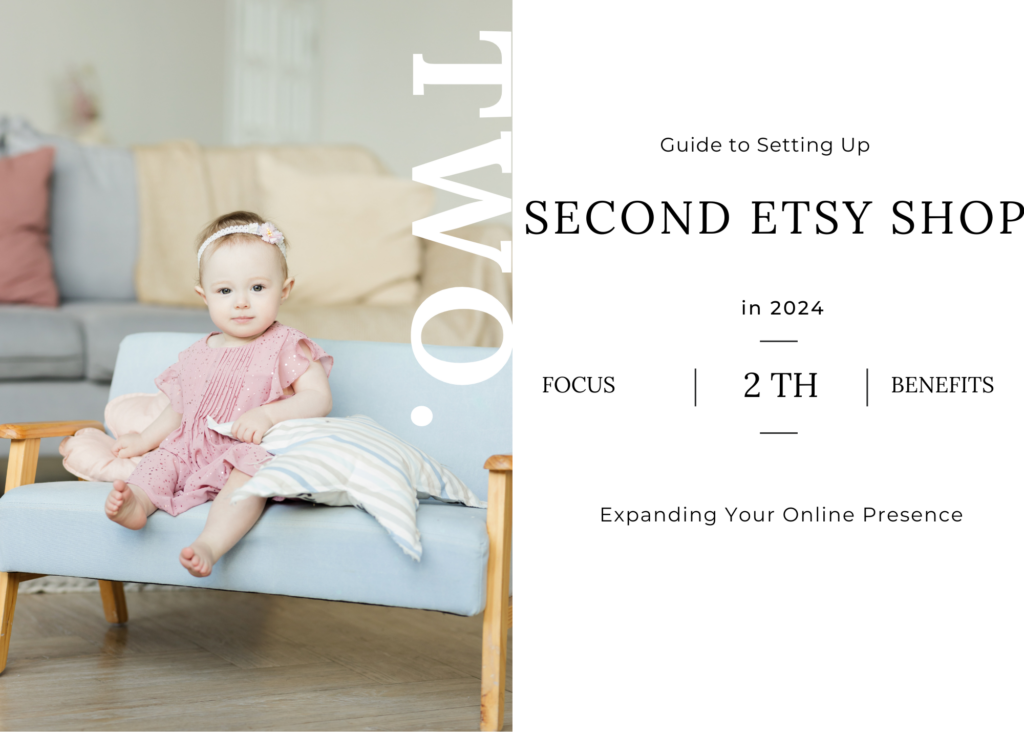The Ultimate Guide to Setting Up a Second Etsy Shop in 2024

Expanding Your Online Presence
Are you an entrepreneur or an Etsy seller looking to expand your online presence? Setting up a second Etsy shop can be a game-changer for your business. By creating a separate shop, you can tap into new markets, target different customer segments, and diversify your income streams.
Having multiple Etsy shops offers several benefits that can help take your business to the next level. Firstly, it allows you to reach a wider audience. Each shop can cater to a specific niche or customer base, increasing your chances of making sales. By offering unique products tailored to different segments, you can attract more customers and expand your reach.
Moreover, establishing an Etsy store also helps in diversifying your income. Relying solely on one shop means putting all your eggs in one basket. If that shop experiences any issues or fluctuations in sales, it could significantly impact your revenue. However, by creating a second Etsy shop with its own niche and product line, you reduce the risk of relying on a single source of income.
To make the most out of setting up an additional Etsy shop, it's important to choose a unique niche for your second store. This will allow you to differentiate yourself from competitors and establish yourself as an expert in that particular market segment. By selecting a niche that aligns with your expertise and passion, you'll be able to create high-quality products that resonate with customers.
Expanding your online presence through multiple Etsy shops is an exciting opportunity for growth and success. In the following sections of this guide, we will delve deeper into the benefits of having multiple shops and provide step-by-step instructions on how to set up a separate account for your second Etsy shop.
Unlocking the Potential: Benefits of Multiple Etsy Shops
Expanding Your Reach
Having multiple Etsy shops allows you to reach a wider audience and increase your chances of making sales. Each shop can be tailored to target different customer segments or niches, allowing you to effectively tap into various markets. By offering a diverse range of products across your multiple Etsy shops, you can attract customers who may have different preferences or interests.
For example, let's say you currently have an Etsy shop that specializes in handmade jewelry. By creating a second Etsy shop dedicated to home decor, you can expand your reach and capture the attention of customers who are specifically looking for unique items to decorate their homes. This way, you're not limited to one market segment and can cater to a broader audience.
Diversifying Your Income
One of the significant advantages of having multiple Etsy shops is the ability to diversify your income streams. Relying solely on one shop means putting all your eggs in one basket. If that particular shop experiences any issues or fluctuations in sales, it could significantly impact your revenue.
However, by establishing additional Etsy stores, you create additional sources of income. Each shop operates independently and has its own customer base and product line. This reduces the risk associated with relying on a single shop for revenue generation. If one shop experiences a decline in sales, the other shops can help offset any potential losses.
Furthermore, having multiple online shops provides flexibility in terms of pricing strategies and product offerings. You can experiment with different pricing structures or introduce new products without affecting the existing customer base or brand reputation.
In summary, setting up multiple Etsy shops offers several benefits such as expanding your reach and diversifying your income streams. In the next section, we will explore how to choose a unique niche for your second Etsy shop.
Finding Your Focus: Selecting a Unique Niche
Researching Market Trends
Before setting up your second Etsy shop, it's essential to research market trends within the Etsy marketplace. Identifying popular niches and trends can help you make informed decisions about the direction of your new shop. Start by exploring different categories and subcategories on Etsy to see what types of products are in demand.
Analyze competition and customer demand to find a profitable niche. Look for gaps in the market where you can offer unique products or put your own spin on existing ones. Pay attention to customer reviews and feedback to understand what customers are looking for and how you can differentiate yourself from competitors.
Choosing a Niche That Aligns With Your Expertise
When selecting a niche for your second Etsy shop, it's important to choose a specialized market that aligns with your expertise and passion. Consider areas where you have knowledge or experience, as this will give you an advantage in creating unique and high-quality products.
Leverage your expertise to create products that stand out from the competition. For example, if you have a background in graphic design, consider opening a shop specializing in personalized stationery or digital prints. By combining your skills with your passion, you can create products that resonate with customers and establish yourself as an expert in your chosen niche.
Additionally, think about the long-term sustainability of the niche you choose. Is there potential for growth? Are there enough customers interested in this product category? Conduct thorough research to ensure that the niche has enough demand to support your business goals.
By selecting a unique niche that aligns with your expertise and passion, you increase the chances of success for your second Etsy shop. In the next section, we will guide you through the step-by-step process of setting up a separate Etsy account.
Step-by-Step Guide: Setting Up a Separate Etsy Account
Understanding Etsy's Policies
Before diving into the process of setting up a separate Etsy account, it's crucial to familiarize yourself with Etsy's rules and regulations for multiple shops. Etsy has specific policies in place to ensure fair and ethical practices among sellers. By understanding these policies, you can ensure compliance and avoid penalties or account suspension.
Take the time to read through Etsy's guidelines regarding multiple shops. Pay attention to any restrictions or limitations that may apply. For example, there may be rules about linking or cross-promoting between your different shops. It's important to understand these policies to maintain a positive selling experience on the platform.
Creating a New Account
Once you have a clear understanding of Etsy's policies, you can proceed with creating a new account for your second Etsy shop. Follow these step-by-step instructions:
- Visit the Etsy website and click on "Sell on Etsy" at the top right corner of the homepage.
- Click on "Open Your Etsy Shop" and select "Register."
- Provide accurate information such as your email address, password, and location.
- Choose a unique username and shop name that reflects your brand and niche.
- Customize your shop by adding a profile picture, banner, and shop announcement.
- Set up payment methods and shipping options for your new shop.
- Create listings for your products, ensuring that they are accurately described and visually appealing.
Remember to optimize your new shop's settings by including relevant keywords in your shop title, tags, descriptions, and product listings. This will help improve visibility in search results and attract potential customers.
By following these steps, you can successfully set up a separate Etsy account for your second shop. In the next section, we will discuss effective management strategies for multiple Etsy shops.
Mastering the Art: Effective Management of Multiple Etsy Shops
Organizing Your Inventory and Orders
Managing multiple Etsy shops requires efficient organization of inventory and orders. Implementing a system to keep track of your products and sales across all your shops is essential for smooth operations. Here are some tips to help you stay organized:
- Utilize inventory management tools: Consider using inventory management software or spreadsheets to track your stock levels, product variations, and restocking needs. This will help you avoid stockouts and ensure timely fulfillment of orders.
- Streamline order processing: Create a standardized process for handling orders from all your shops. This can include setting up notifications for new orders, printing shipping labels in bulk, and scheduling regular shipping pickups or drop-offs.
- Separate storage spaces: If possible, allocate separate storage spaces for the inventory of each shop. This will minimize confusion and make it easier to locate specific products when fulfilling orders.
Setting Realistic Goals and Prioritizing Tasks
To effectively manage multiple Etsy shops, it's crucial to set realistic goals for each shop and prioritize tasks accordingly. Here's how you can achieve this:
- Establish achievable goals: Set specific, measurable, attainable, relevant, and time-bound (SMART) goals for each shop. These goals could be related to sales targets, product launches, or customer engagement metrics.
- Break down tasks: Divide larger projects into smaller tasks that can be accomplished within a reasonable timeframe. Prioritize these tasks based on their importance and urgency.
- Manage your time effectively: Create a schedule or calendar to allocate dedicated time slots for working on each shop. Avoid multitasking excessively as it can lead to decreased productivity and quality of work.
By organizing your inventory and orders efficiently while setting realistic goals and prioritizing tasks, you can successfully manage multiple Etsy shops without feeling overwhelmed.
Boosting Visibility: SEO Optimization and Product Promotion
Keyword Research and Optimization
To improve the visibility of your Etsy shops, it's crucial to conduct thorough keyword research and optimize your shop titles, tags, and descriptions. Here are some steps to help you with Etsy shop SEO:
- Identify relevant and high-ranking keywords: Use keyword research tools like Google Keyword Planner or Etsy's own search bar to find keywords that are popular within your niche. Look for keywords with a good search volume and low competition.
- Optimize your shop titles: Incorporate targeted keywords into your shop titles to improve search engine rankings. Ensure that the titles accurately describe your products while including relevant keywords that potential customers may use when searching for similar items.
- Utilize tags effectively: Choose tags that are specific to each product listing and include relevant keywords. This will help potential customers find your products when they search for specific terms on Etsy.
- Craft compelling product descriptions: Write detailed and engaging descriptions for each product, incorporating relevant keywords naturally. Focus on highlighting the unique features, benefits, and uses of the product while keeping the description informative and easy to read.
Utilizing Social Media and Online Marketing
In addition to optimizing your Etsy shop for search engines, promoting your products through social media platforms can significantly boost visibility. Here's how you can utilize social media and online marketing effectively:
- Promote your products across various social media platforms: Create accounts on popular platforms like Instagram, Facebook, Pinterest, or Twitter to showcase your products visually. Share high-quality images of your products along with engaging captions that highlight their unique qualities.
- Engage with your target audience: Interact with potential customers by responding to comments, messages, or inquiries promptly. Encourage user-generated content by running contests or giveaways that involve sharing photos or reviews of your products.
- Collaborate with influencers: Partnering with influencers who have a significant following in your niche can help expose your products to a wider audience. Reach out to relevant influencers and offer them free products in exchange for honest reviews or promotional posts.
By implementing effective SEO strategies and utilizing social media and online marketing, you can improve the visibility of your Etsy shops and attract more potential customers.
Building a Cohesive Brand: Consistent Branding for Multiple Etsy Shops
Creating a Brand Identity
Establishing a strong brand identity is crucial for standing out in the competitive Etsy marketplace. Here's how you can create a unique brand identity that resonates with your target audience:
- Develop a unique brand identity: Define your brand values, mission, and vision. Consider what sets your products apart from others and how you want to be perceived by customers. Use this information to craft a compelling brand story that reflects your values and resonates with your target audience.
- Consistently apply your brand elements: Ensure that your brand elements, such as logo, color palette, typography, and imagery, are consistent across all your Etsy shops. This consistency helps customers recognize and remember your brand easily.
Maintaining Consistent Product Photography and Packaging
Consistency in product photography and packaging plays a vital role in creating a cohesive brand experience for customers. Follow these tips to maintain consistency across all your Etsy shops:
- Ensure consistent product photography style and quality: Develop a photography style guide that outlines the desired aesthetics, lighting, angles, and props for product photos. Apply this guide consistently across all your shops to create a cohesive visual identity.
- Pay attention to packaging details: Packaging is an opportunity to reinforce your brand image. Design packaging materials such as boxes, labels, or thank-you notes that align with your overall branding strategy. Make sure the packaging reflects the quality of your products and provides a memorable unboxing experience for customers.
By creating a strong brand identity and maintaining consistency in product photography and packaging across all your Etsy shops, you establish credibility and build trust among customers. In the next section, we will explore how setting up a second Etsy shop can take your business to the next level.
Taking Your Etsy Business to the Next Level
Setting up a second Etsy shop can be a game-changer for your online business. It offers the opportunity to significantly expand your online presence and reach a wider audience. By choosing a unique niche for your second shop and effectively managing multiple shops, you can take your Etsy business to new heights.
Having multiple Etsy shops allows you to target different customer segments and cater to diverse market needs. This increases your chances of making sales and diversifies your income streams, reducing the risk of relying on a single shop for revenue. By leveraging SEO optimization techniques, promoting your products through social media, and maintaining consistent branding across all your shops, you can boost visibility and attract more potential customers.
Optimizing SEO is crucial for improving search engine rankings and driving organic traffic to your Etsy shops. Conduct thorough keyword research, optimize your shop titles, tags, and descriptions with targeted keywords, and ensure that your listings are well-optimized for search engines.
Promoting your products through social media platforms allows you to engage with your target audience directly. Share high-quality images of your products, interact with potential customers, collaborate with influencers in your niche, and encourage user-generated content.
Consistent branding across all your Etsy shops helps establish credibility and build trust among customers. Develop a unique brand identity that reflects your values and consistently apply it to all aspects of your business, from logos to product photography to packaging.
By following these strategies and taking advantage of the benefits offered by setting up a second Etsy shop, you can elevate your online business to the next level of success.





